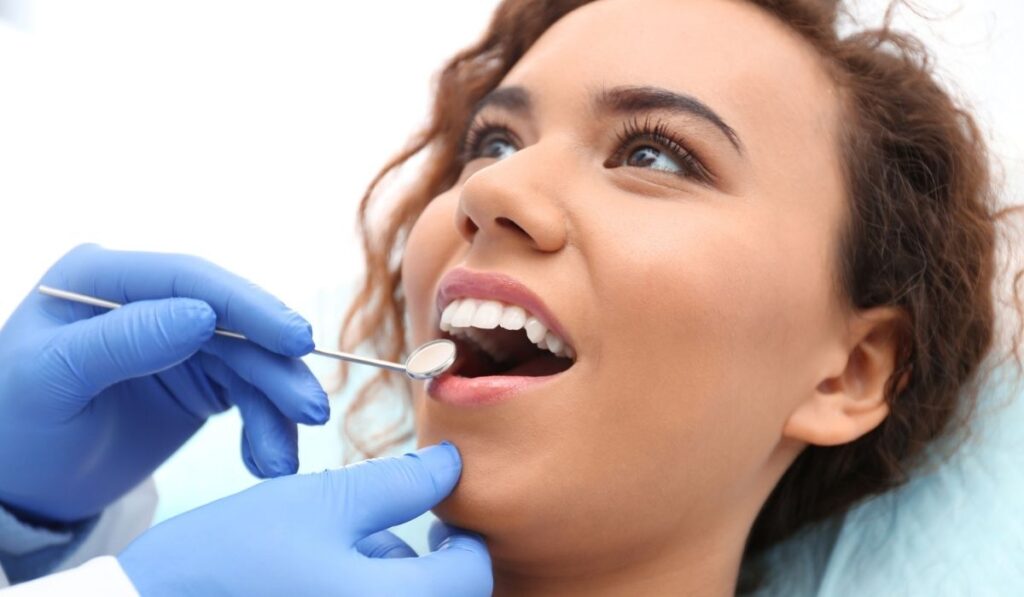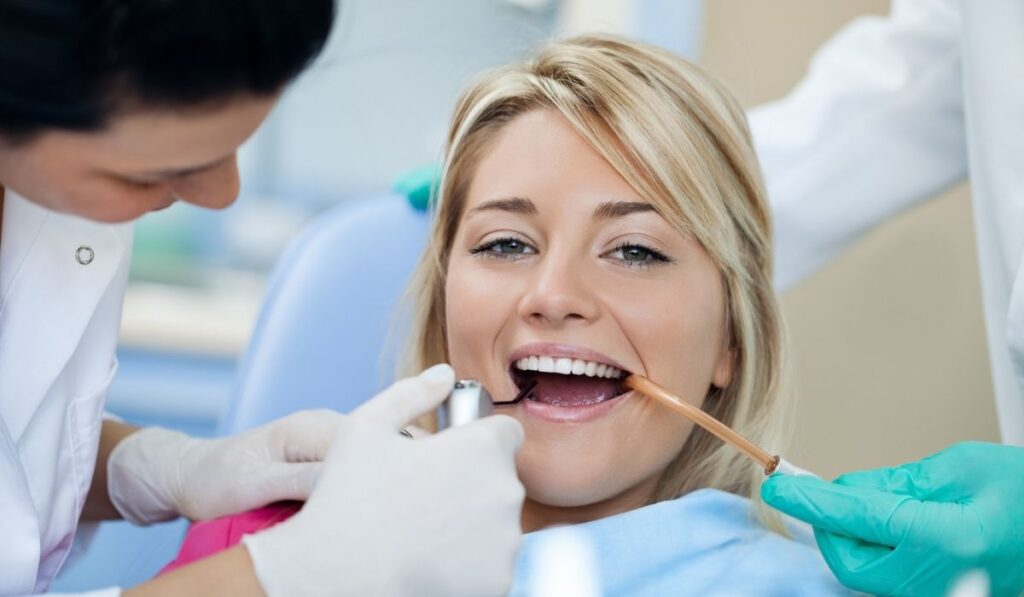From wine to coffee to chocolate, we all have our favorite treats. But as you’re enjoying these wonderful foods and drinks, you probably don’t spend too much time thinking about what they’re doing to your teeth. The truth is that they can leave stains, impacting the way your teeth look and reducing their whiteness.
In order to remove teeth stains, you can try special whitening strips, toothpaste, pens, and gels that can be acquired over-the-counter or online. Natural remedies include baking soda, coconut oil, and apple cider vinegar. In some cases, professional treatment is the best option.
Food and drink are major causes of staining, but certain medications, tobacco products, and other substances can also contribute. Let’s take a look at what causes stains, how to treat them, and how to prevent more from occurring in the future.
What Causes Teeth Stains?

The main cause of stains on teeth is food and drinks. Stains appear as a yellow-brown color or one that is slightly darker. They can appear on many teeth or just certain ones.
Many dark foods and drinks have a chemical that stains teeth enamel. Other food have artificial flavors or dyes that act similarly. Here are some items that are known to cause staining:
- Wine
- Coffee
- Soda
- Candy/chocolate
- Blueberries and other acidic fruit
Food and drinks aren’t the only culprits. Nicotine and tobacco products can also make your teeth yellow, as will any tartar that builds up in your mouth. Tooth decay and poor oral hygiene contribute to staining too.
Sometimes, it’s a more natural occurrence. As you get older, enamel wears away, exposing the yellowness underneath. Genetics can play into this as well. Factors include the tooth enamel’s strength, how it responds to acids, and any condition that prevents proper bone and teeth formation or growth.
Other causes of staining on teeth include:
- Certain medications
- Dental work (fillings, crowns)
- Too much fluoride
- Bacterial infections
- Exposure to toxins
Some yellowness of your teeth can be expected and is unavoidable. But it is always important to practice good oral hygiene, eat healthy, and address any illnesses or medical conditions.
Types of Teeth Stains
Before figuring out how to treat stains, you need to know what type of stain you have. Then, you can find the best method based on the type.
There are two main types of teeth stains: extrinsic and intrinsic. Extrinsic is a stain on the tooth’s outer part, or the enamel. It won’t get beneath the surface of the enamel and is fairly easy to remove.
Causes of extrinsic stains include dark-colored drinks and tobacco. These stains won’t come off from brushing and can be treated with an at-home teeth-whitening solution or a procedure done by a dentist.
Intrinsic stains are more permanent and more serious. They occur when pigments get into the structure of the enamel and discoloration forms on the inner layer. Causes include erosion, acidic food and drinks, too much fluoride, certain medications (especially tetracycline), and brushing your teeth too hard.
These stains don’t come off as easily as extrinsic ones. An at-home teeth-whitening product won’t work; you’ll need to visit a dentist for treatment.
How to Remove Stains From Your Teeth
From home remedies to professional, in-person solutions, there are several ways to remove stains from teeth. You might try one method and then switch to another to find out which one works the best.
Brushing Your Teeth
It starts with the simple act we all should do at least twice per day. But it’s important to brush correctly. Don’t apply too much pressure with your toothbrush because that can lead to abrasion and more staining. Soft strokes in circles for two minutes works well.
Although you might be tempted to brush right after consuming acidic foods or anything that stains teeth, wait at least 30 minutes. This will prevent you from brushing away your enamel.
Whitening Toothpaste
Using a whitening toothpaste such as this one from Colgate (on Amazon) can help, too. These toothpastes contain an ingredient to help remove stains of all types and make your teeth look whiter. Your dentist can recommend one that works best for your specific needs.
Whitening Strips
There are many whitening strips on the market, and these can work well. The product contains peroxide in a gel that is already on a strip. You take it and apply it directly to your teeth for a certain amount of time.
Follow the instructions on the specific product you buy. Be sure not to put the strips on your gum, as doing so can cause damage.
Whitening strips come in many different varieties. You should be able to find one that suits your needs. We recommend Colgate’s Vivid Plus Strips (on Amazon).
Whitening Pens
Whitening pens are very easy to apply. The pen contains a gel that you put right on your teeth after brushing. Follow the instructions carefully because you need to wait a certain amount of time before eating or drinking again. Some whitening pens contain a substance that is both safe for your enamel and able to treat intrinsic and extrinsic stains.
We recommend the Colgate Optic White Overnight Teeth Whitening Pen (on Amazon).
Teeth-Whitening Gel
Teeth-whitening gels, like this one from Advance+ (on Amazon), contain a higher amount of peroxide than teeth-whitening toothpastes. Therefore, you need to use a special tray so that the peroxide only touches your teeth and not your gums or other parts of your mouth.
The best option would be to get a custom tray from your dentist, but they are also available over the counter. A custom one will fit your mouth much better and offer the most protection, so it could be worth the extra money. Talk to your dentist for more information.
Natural Home Remedies for Removing Stains
Besides various products specifically designed to whiten your teeth, you can also try natural methods. You can try these options right from your home with items you either have or can pick up anywhere.
- Baking soda and hydrogen peroxide: Mix 1 tablespoon of baking soda and 2 tablespoons of hydrogen peroxide to form a paste. Brush with this paste and rinse your mouth out. This method can be used every day.
- Coconut oil: Put 1 or 2 teaspoons of coconut oil in your mouth, and swish it around for 10-30 minutes. The oil removes bacteria and plaque. Don’t swallow the oil and don’t let it get to the back of your throat. This is because the oil contains toxins. After using, rinse your mouth with water, drink a glass of water, and brush your teeth.
- Apple cider vinegar: Mix a small amount of apple cider vinegar with 6 ounces of water. Swish around for 30 seconds, rinse, and brush your teeth. This substance can cause damage to your teeth, which is why it’s important to not use it for a long time.
- Lemon, orange, or banana peels: You can rub these on your teeth for 2 minutes and it may whiten them. Rinse and brush afterward. There is no scientific evidence supporting this method, so proceed with caution. Also, since fruit is acidic, it can work against you and damage the enamel. If you try this and your teeth become more sensitive, stop.
- Activated charcoal: Because charcoal is very absorbent, it can remove stains and also gets rid of bacteria. Take a small amount, put it on your toothbrush and brush softly. Instead of brushing regularly, you also can pat it on your teeth or mix the charcoal with water to make a mouthwash.
Activated charcoal can be abrasive so be careful if you use it. Avoid using charcoal daily or for long periods of time, as it can thin out the enamel and expose the dentin layer beneath, which is yellow in color. - Consume fruits and vegetables with high amounts of water: This can include watermelon, strawberries, peaches, cantaloupe, cucumbers, and lettuce. Eating these fruits and vegetables can clean your mouth and remove plaque, stains, and bacteria.
Dental Procedures for Stain Removal

If you don’t want to try an at-home method to remove stains on your teeth or prefer having it done by a professional, you can always go to a dentist. The treatments they offer will be the most effective at making your teeth look better. There are many options that should be discussed ahead of time with your dentist.
- Professional whitening: A professional whitening is the safest way to bleach your teeth and produces immediate results, much faster than any at-home method. Gum damage and tooth sensitivity are less likely because you are in the hands of experienced professionals.
However, it is more expensive, and results can be unpredictable and might not last (this depends on your habits and food preferences).
- Dental bonding: In this method, a resin is made, polished with a light, and sealed to your tooth. It will be designed to match what your other teeth look like, improve your appearance, and restore decayed teeth. It can last about 10 years in the best-case scenario and with proper maintenance, but many patients may see the results diminish much earlier.
- Professional cleaning: During a professional cleaning, the hygienist or dentist will remove plaque, tartar, conduct an oral cancer screening, and use a fluoride-based toothpaste to clean your teeth. Just from a cleaning, you can leave with whiter, healthier teeth and learn more about how to better take care of them.
- Veneers: These are coverings placed on the front of your teeth. They are designed to look like your natural teeth and will be made to match them. If you have stains that can’t be removed or permanent defects in your enamel that can’t be corrected with traditional whitening techniques, then veneers are a good option. Note that once put on, veneers can’t be removed.
How to Prevent Teeth From Staining
Of course, no one wants stained teeth. While it may be hard to completely avoid the many foods and drinks that lead to staining, you can take steps to prevent it. Here are some ways to reduce the chances of getting stained teeth:
- Brush with a fluoride-based toothpaste twice a day
- Floss once a day
- Rinse with water after eating
- Use mouthwash with fluoride once a day
- Don’t use nicotine or tobacco
- Get regular dental cleanings and checkups twice a year
With food and drink playing a major role in what your teeth look like, you should know that reducing consumption of certain items can help. Try to limit your intake of wine, coffee, soda, candy and acidic fruits.
Additionally, other foods an actually help by strengthening the enamel and preventing stains. These include:
- Lettuce, kale, broccoli, and spinach
- Cheeses and fermented yogurts
- Fruits high in fiber like apples, pears, and celery
- Carrots, ginger, and other foods high in antioxidants
- Whole grains
- Nuts
Following the methods in this guide can help you have better-looking teeth that don’t stain and remain healthy. This is an important part of your oral hygiene, overall health, and well-being, so don’t overlook it and take the necessary steps to improve your teeth.


